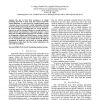Free Online Productivity Tools
i2Speak
i2Symbol
i2OCR
iTex2Img
iWeb2Print
iWeb2Shot
i2Type
iPdf2Split
iPdf2Merge
i2Bopomofo
i2Arabic
i2Style
i2Image
i2PDF
iLatex2Rtf
Sci2ools
WEBI
2009
Springer
2009
Springer
Learning Deep Web Crawling with Diverse Features
—The key to Deep Web crawling is to submit promising keywords to query form and retrieve Deep Web content efficiently. To select keywords, existing methods make a decision based on keywords’ statistic information deriving from TF and DF in local acquired records, thus work well only in textual databases providing full text search interfaces, whereas not well in structured databases of multi-attribute or field-restricted search interfaces. This paper proposes a novel Deep Web crawling method. Keywords are encoded as a tuple by its linguistic, statistic and HTML features so that a harvest rate evaluation model can be learned from the issued keywords for the un-issued in future. The method breaks through the assumption of plain-text search made by existing methods. Experimental results show that the method outperforms the state of the art methods. Keywords-Hidden Web; Deep Web surfacing; machine learning
Deep Web | Internet Technology | Keywords | Web Crawling | WEBI 2009 |
| Added | 25 May 2010 |
| Updated | 25 May 2010 |
| Type | Conference |
| Year | 2009 |
| Where | WEBI |
| Authors | Lu Jiang, Zhaohui Wu, Qinghua Zheng, Jun Liu |
Comments (0)

